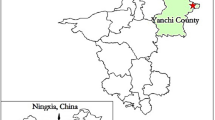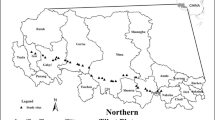Abstract
Soil water (W), nitrogen (N), and phosphorus (P) availability were manipulated for 2 years in a factorial experiment in a semi-arid grassland in the southeastern Keerqin Sandy Lands, China, to determine what soil resource(s) limits plant growth. We quantified the responses of leaf chemical and anatomical traits for the dominant annual herb Chenopodium acuminatum in this ecosystem to test hypotheses about leaf form and function in relation to soil resource limitation. Nitrogen was the principal limiting factor, and N treatments (alone and in combination with W and P) elicited consistent increases in leaf size and decreases in leaf thickness and water content. Differentiation in the leaf mesophyll between palisade and spongy parenchyma was lacking in N deficient plants and stimulated in all +N treatments. The greater tissue density and cell packing may promote more efficient light capture with improved N nutrition. Mixed additions of W, N, and P were generally more advantageous to leaf expansion and nutrient balance than their isolated additions, therefore water and nutrients synchronous management would be a better approach to promote plant growth at the semi-arid region.




Similar content being viewed by others
References
Aranda I, Pardo F, Gil L, Pardos JA (2004) Anatomical basis of the change in leaf mass per area and nitrogen investment with relative irradiance within the canopy of eight temperate tree species. Acta Oecol 25:187–195
Casson S, Gray JE (2008) Influence of environmental factors on stomatal development. New Phytol 178:9–23
Chen F-S, Zeng D-H, He X-Y (2006) Small-scale spatial variability of soil nutrients and vegetation properties in semi-arid northern China. Pedosphere 16:778–787
Cramer J, Fahey TJ, Battles JJ (2000) Patterns of leaf mass, area and nitrogen in young northern hardwood forests. Am Midl Nat 144:253–264
Dodd IC, Munns R, Passioura JB (2002) Does shoot water status limit leaf expansion of nitrogen-deprived barley? J Exp Bot 53:1765–1770
Ellsworth DS, Reich PB (1993) Canopy structure and vertical patterns of photosynthesis and related leaf traits in a deciduous forest. Oecologia 96:169–178
Fahn A (1990) Plant anatomy, 4th edn. Pergamon Press, Oxford
Garnier E, Laurent G (1994) Leaf anatomy, specific mass and water content in congeneric annual and perennial grass species. New Phytol 128:725–736
Koerselman W, Meuleman AFM (1996) The vegetation N:P ratio: a new tool to detect the nature of nutrient limitation. J Appl Ecol 33:1441–1450
Lacey AJ (1999) Light microscopy in biology: a practical approach, 2nd edn. Oxford University Press, Oxford
Liu G-S (1996) Standard methods for the observation and analysis of Chinese ecosystem research network: soil analysis and profile description. Standards Press of China, Beijing (in Chinese)
Mader SS (1994) Inquiry into life: laboratory manual, 7th edn. William C. Brown Publishers, Dubuque
Meziane D, Shipley B (1999) Interacting determinants of specific leaf area in 22 herbaceous species: effects of irradiance and nutrient availability. Plant Cell Environ 22:447–459
Meziane D, Shipley B (2001) Direct and indirect relationships between specific leaf area, leaf nitrogen and leaf gas exchange: effects of irradiance and nutrient supply. Ann Bot 88:915–927
Nautiyal S, Badola HK, Pal M, Negi DS (1994) Plant responses to water stress: changes in growth, dry matter production stomatal frequency and leaf anatomy. Biol Planta 36:91–97
Niinemets Ü (1999) Components of leaf dry mass per unit area—thickness and density—alter leaf photosynthetic capacity in reverse directions in woody plants. New Phytol 144:35–47
Niinemets Ü, Kull K (2003) Leaf structure vs. nutrient relationships vary with soil conditions in temperate shrubs and trees. Acta Oecol 24:209–219
Palmer SJ, Berridge DM, McDonald AJS, Davies WJ (1996) Control of leaf expansion in sunflower (Helianthus annus L.) by nitrogen nutrition. J Exp Bot 47:359–368
Picotte JJ, Rhode JM, Cruzan MB (2009) Leaf morphological response to variation in water availability for plants in the Piriqueta caroliniana complex. Plant Ecol 200:267–275
Radin JW, Boyer JS (1982) Control of leaf expansion by nitrogen nutrition in sunflower plants: role of hydraulic conductivity and turgor. Plant Physiol 69:771–775
Raven PH, Evert RF, Eichhorn SE (1986) Biology of plants, 4th edn. Worth Publishers, Inc, New York, pp 424–432
Reich PB, Ellsworth DS, Walters MB, Vose JM, Gresham C, Volin JC, Bowman WD (1999) Generality of leaf trait relationships: a test across six biomes. Ecology 80:1955–1969
Salisbury EJ (1927) On the causes and ecological significance of stomatal frequency with special reference to the woodland flora. Philos Trans Royal Soc Lond (B) 216:1–65
Schippers P, Olff H (2000) Biomass partitioning, architecture and turnover of six herbaceous species from habitats with different nutrient supply. Plant Ecol 149:219–231
SPSS Inc. (2001) SPSS for Windows (10.0). Chicago, IL, USA
Sperry JS, Tyree MT (1990) Water-stress-induced xylem embolism in three species of conifers. Plant Cell Environ 13:427–436
Westoby M, Wright IJ (2006) Land-plant ecology on the basis of functional traits. Trends Ecol Evol 21:261–268
Witkowski ETF, Lamont BB (1991) Leaf specific mass confounds leaf density and thickness. Oecologia 88:486–493
Wright IJ, Reich PB, Westoby M (2001) Strategy-shifts in leaf physiology, structure and nutrient content between species of high and low rainfall, and high and low nutrient habitats. Funct Ecol 15:423–434
Yu Z-Y, Zeng D-H, Jiang F-Q, Zhao Q (2009) Responses of biomass to the addition of water, nitrogen and phosphorus in Keerqin sandy grassland, Inner Mongolia, China. J For Res 20:23–26
Zeng D-H, Hu Y-L, Chang S-X, Fan Z-P (2009) Land cover change effects on soil chemical and biological properties after planting Mongolian pine (Pinus sylvestris var. mongolica) in sandy lands in Keerqin, northeastern China. Plant Soil 317:121–133
Acknowledgments
This study was supported by Grants from the National Key Technologies R&D Program of China (No. 2006BAD26B0201-1), the National Natural Science Foundation of China (Nos. 30800143 and 30960311) and the National Key Basic Research Program of China (No. 2007CB106803). We thank Yi Gan, Hai-Jun Hu, and Shi-gen Wu for their field work; Ming Zhong, Lu Gan, Yi Liu, and Qiu-Xiang Tian for laboratory analyses.
Author information
Authors and Affiliations
Corresponding author
Rights and permissions
About this article
Cite this article
Chen, FS., Zeng, DH., Fahey, T.J. et al. Response of leaf anatomy of Chenopodium acuminatum to soil resource availability in a semi-arid grassland. Plant Ecol 209, 375–382 (2010). https://doi.org/10.1007/s11258-010-9778-x
Received:
Accepted:
Published:
Issue Date:
DOI: https://doi.org/10.1007/s11258-010-9778-x




